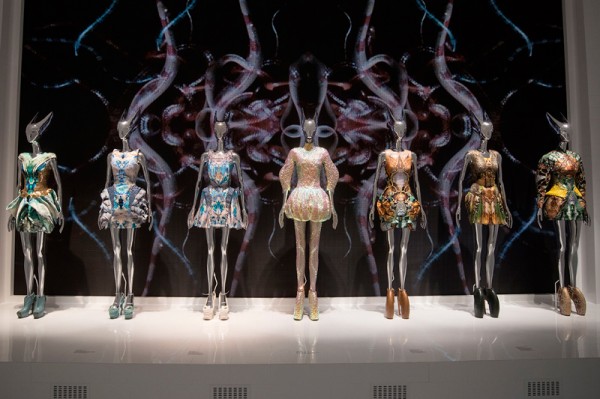L'(ee) Enfant Terrible
 Thirsty for JUICE content? Quench your cravings on our Instagram, TikTok and WhatsApp
Thirsty for JUICE content? Quench your cravings on our Instagram, TikTok and WhatsApp

A big fan of the late Alexander McQueen, Jiman Casablancas goes back in time to the day the British designer caught his attention, as he walks through the renowned posthumous Savage Beauty exhibition in London.
“London is where I was brought up. It’s where my heart is and where I get my inspiration,” a quote on the wall hits you immediately upon entering the Victoria and Albert Museum in London.
It’s March 16, a Monday, and I’m early for my 3:30PM time slot to visit the Alexander McQueen Savage Beauty exhibition, which was opened to the public only days ago, and will run until August 2 this year. When I first heard about the exhibition, I knew right then and there that I have to, by hook or by crook, make myself available for it: I already know it’s nothing less than a spiritual homecoming of epic proportions – especially for me.
The year was 1999, and Kuala Lumpur is without a doubt an Asian party central, where world-renowned DJs from all over the world would come and play on a weekly basis. There were legal (and illegal) raves everywhere, and the scene was buzzing with nothing but love. It was a time when weekends would start on Wednesdays, and human technology was getting an upgrade with the introduction of smaller versions of cell phones and satellite televisions. Despite that, information was still scarce. Those who are in the know on underground international designers are those who are privileged enough to travel to fashion cities like London, New York and Japan, who would then parade these outfits when out at legendary KL night establishments.
I was a student then. My clothes were made up of vintage picks purchased from either Chow Kit Road or Sungei Wang Plaza, never the high-end stuff. I have, however, developed a burgeoning interest in all things fashion. This is especially due to the habit of watching Fashion TV with Jeannie Baker religiously, MTV’s House of Style and Style with Elsa Klench. Watching these shows, I got to know the fashion tycoons like Anna Sui, Bill Blass, Todd Oldham, Gianni Versace, Oscar de la Renta, Isaac Mizrahi, Escada, Comme des Garcon, Yohji Yamamoto, Thierry Mugler, Jean Paul Gaultier, to name a few.
When the Internet was activated on our side of the world, I remember that day clearly, sitting in front of a computer in an Internet café in Kajang, searching for just about anything the then phenomena could then conjure up on screen at the sheer command of the cursor in my hand.
One thing led to another, and I ended up watching a show featuring Shalom Harlow with a designer I hardly knew anything about. It was Alexander McQueen’s Spring/Summer 1999 collection, inspired by the Arts and Crafts Movement. The feline-like Miss Harlow was standing on a turntable, rotating in slow motion, showing off a white cotton muslin dress with white synthetic tulle, flagged with two huge robotic arms that move to the sound of classical music.
My breath was caught in my throat, when the two industrial machines started spraying paint all over the tube dress! It was jaw dropping, to say the least, seeing something so pure being “bastardised” with black and neon green aerosol paint; it was of course unexpected that what I am watching then was the making of one of the most iconic moments in the fashion world, the step through the threshold into something modern and relevant to what was happening in the world then. Never have I seen fashion, art and technology get together so seamlessly in such a way before that, and since then, I got hooked. Alexander McQueen became a personal obsession of mine.

You could say that the late Alexander McQueen’s career is beyond comparison, even after his untimely death on February 11, 2010. He would stalk an idea instinctively at its heels, not unlike a predator tracking its prey. At their best, his shows were feats of magic and drama as it showcases the sheer beauty of high fashion. Known as “the original bad boy of fashion”, McQueen was both a traditionalist and an avant-gardist, and all that he ever was is laid out bare at the exhibition, through a carefully crafted synergy between clothes and setting, with a three-dimensional walk through of the many complex elements within the designer’s imagination.
There are at least 10 different chambers of different themes of Lee’s collection – from his graduation collection, right down to Plato Atlantis, his 2010 swansong collection of a futuristic underwater world. Savage Beauty is curated to perfection. Each room are all so specific, so personal and so visceral that once you see them, they are implanted in your head. John Gosling, who has created the accompaniments for all of McQueen’s runway presentations, was commissioned to design the sound in each gallery.
It helps, too, that they have earned nicknames nearly as evocative as the clothes themselves: The They Shoot Horses, Don’t They? Collection (Spring/Summer 2004) is presented in a Depression-era dancehall, where the models have to dance till they drop, and their dresses that started out as perfect specimens, end up in tatters; The Wolves Collection (Autumn/Winter 2002) is shown at the Conciergerie in Paris, where Marie Antoinette was held up before she was sent to the guillotine; the now iconic Highland Rape Collection from Autumn/Winter 1995, which mixed flesh baring see through materials with eruptions of tartan – a clash and juxtaposition intended for the condemnation of England’s historic bullying of Scotland; and last but not the least, my favourite collection, without a doubt, The Horn of Plenty (Autumn/Winter 2009), a tribute to his mother, Joyce Barbara McQueen, which he once described as “not safe in any way. It’s a punked-up McQueen girl. A parody of a certain ideal, of a woman who never existed in the first place. It’s Audrey Hepburn in Breakfast at Tiffany’s. It’s Dior. It’s Valentino’s ladies who lunch. I want people to look at it and say, ‘What’s that? What’s that? What the hell is that?’” – Ah, McQueen, the king (or queen?) of metaphor!
Hours later after I have had my fill of Lee, I left the Victoria and Album Museum to a cold and gloomy evening, not feeling exactly satiated, but rather mournful. I suppose the typical grey London weather reminds me of his suicide about five years back, believed to be due to the great depression he fell into after his mother’s passing.
Unbeknownst to me, the day after, the day I leave London to head back to Kuala Lumpur, March 17 – it’s Lee’s birthday, or what could have been his 45th one. While waiting to board, I scroll through my Instagram feed filled with his photo and birthday wishes from the likes of Naomi Campbell, Katy England, Sarah Jessica Parker, Edward Enninful… People who are not just collaborators to Lee, but also good friends.
To say that he’s “gone too soon” is an understatement. He was truly the most brilliant designer of my generation, and he has definitely left a vacuum in the fashion world – and mine.
Jiman has honned himself a skilful public relations career after years of experience in the industry. Despite his 9-to-5 white-collar job, Jiman is far from tamed. He may have his leather jacket on all the time, but you’d be surprised with the kind of creative ideas he has hidden under his tattooed sleeves.
This opinion piece was featured in the HANGER Spring/Summer 2015 issue.




